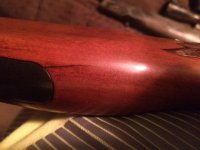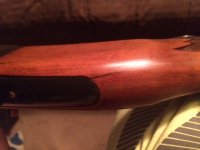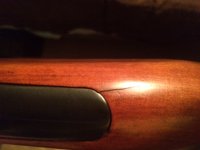You are using an out of date browser. It may not display this or other websites correctly.
You should upgrade or use an alternative browser.
You should upgrade or use an alternative browser.
Crack in stock
- Thread starter Jiggy300
- Start date
I have had some stocks fixed over the years and had an older Weatherby fixed last fall . I will give you a very good shop to call good prices and one of the very best ,
BACHELDER Gunmakers
700 Plymouth Ave Grand Rapids Mi. 49505
616 459 3636
They fixed the Weatherby and i can not find the spot it looks as new .
BACHELDER Gunmakers
700 Plymouth Ave Grand Rapids Mi. 49505
616 459 3636
They fixed the Weatherby and i can not find the spot it looks as new .
Dixie Gunsmithing
Moderator Emeritus
Snyper is correct, in that the action has loosened up in the bedding, and firing has caused the split. I would see about epoxy bedding it, and fixing the crack in the process.
The crack can be fixed, by allowing some thin slow-setting epoxy to run in or be injected into the crack, then you pull it together with some surgical tubing, etc. until it sets. Another way to clamp it is to use a piece of thick belt leather, and wrap that around the stock, leaving about a 1/2" wide opening at the crack, in the leather. Wrap a piece of iron stovepipe wire around the leather, then twist the wire, which will draw the crack tight on the epoxy.
The crack can be fixed, by allowing some thin slow-setting epoxy to run in or be injected into the crack, then you pull it together with some surgical tubing, etc. until it sets. Another way to clamp it is to use a piece of thick belt leather, and wrap that around the stock, leaving about a 1/2" wide opening at the crack, in the leather. Wrap a piece of iron stovepipe wire around the leather, then twist the wire, which will draw the crack tight on the epoxy.
FrankenMauser
New member
Very common crack on Savage 99s. I fix several of them each year. Just fixed one on a 308 last week. In order to repair it correctly, the crack will be spread, epoxy injected, then the recoil lug area at the back of the action needs to be bedded to keep it from happening again.
dakota.potts
New member
I'm currently repairing a crack very similar to this on a Remington Model 11 forend where these cracks are common. I tried Gorilla Glue but that didn't hold well and was difficult to get into the crack. Acraglass was much easier to inject because it's thinner and runs easier. I used a disposable syringe (I think we got them in bulk from a veterinary supply company). I squeezed the forend to expose as much of the crack as possible, injected it with a syringe, used a fine dental pick to push it in wherever possible, and then flexed the forend open and closed a couple of times to make sure the acraglass would work its way in. Then clamped it and let it cure overnight.
FrankenMauser
New member
Just an FYI on syringes:
You can usually get "non-sterile" syringes cheaper from industrial/chemical supply places, than from medical/veterinarian supply outfits.
Blunt-tip needles, various sharp-grind needles, plastic needles, or versions without an applicator needle.
I can't remember where I got my last case (10 mL), but they ran about half the price of 'medical-grade' syringes, simply due to the lower cleanliness requirements, cheaper packaging, and lack of irradiation for sterilization.
You can usually get "non-sterile" syringes cheaper from industrial/chemical supply places, than from medical/veterinarian supply outfits.
Blunt-tip needles, various sharp-grind needles, plastic needles, or versions without an applicator needle.
I can't remember where I got my last case (10 mL), but they ran about half the price of 'medical-grade' syringes, simply due to the lower cleanliness requirements, cheaper packaging, and lack of irradiation for sterilization.
crack in stock
I've repaired cracked/broken shotgun stocks. Bolt actions or some anyway seem to have cracked a lot.
It won't be quite as new but the guns were not collectables anyway.
I assessed the crack or break and determined if to us two or three screws.
Smaller the better. I used long far longer than the stock wrist is wide.
Brass wood screws and good drill sized to slightly less than the screw thread. Sam size as the inside of the thread.
Clamped the pieces tight together and no shift from proper alignment.
Drilled through.
Removed the clamps or ties or small bungies, if they work
Mixed up more than enough epoxy and made sure to get epoxy on all the cracked/broke surface.
Clamp or fasten together tightly. The glue will ooze out and then drive the screws in carefully . Leave screw thread showing on both sides.
Let it sit longer than called for glue to cure.
Cut off excess screw leaving just a bit on each side. Tape over the screws and punch them through. Carefully file off the excess screw.
You will be amazed how close you can get without damaging the finish.
The screws must bee absolutely flush with the wood finish.
May have to use 1000 grit to get it down absolutely undetectable feel.
If you have to touch the older guns used linseed oil finish even the five dollar shotguns. If you have to sue finish , it will actually end up a bit better.
Finish on the screw will make it absolutely flush and no chance of verdegris on the metal.
I ended up fine sanding the ones I did and refinished better than new guns but you could see the brass dots. The glue can be scraped flush but refinishing is more enjoyable.
I've repaired cracked/broken shotgun stocks. Bolt actions or some anyway seem to have cracked a lot.
It won't be quite as new but the guns were not collectables anyway.
I assessed the crack or break and determined if to us two or three screws.
Smaller the better. I used long far longer than the stock wrist is wide.
Brass wood screws and good drill sized to slightly less than the screw thread. Sam size as the inside of the thread.
Clamped the pieces tight together and no shift from proper alignment.
Drilled through.
Removed the clamps or ties or small bungies, if they work
Mixed up more than enough epoxy and made sure to get epoxy on all the cracked/broke surface.
Clamp or fasten together tightly. The glue will ooze out and then drive the screws in carefully . Leave screw thread showing on both sides.
Let it sit longer than called for glue to cure.
Cut off excess screw leaving just a bit on each side. Tape over the screws and punch them through. Carefully file off the excess screw.
You will be amazed how close you can get without damaging the finish.
The screws must bee absolutely flush with the wood finish.
May have to use 1000 grit to get it down absolutely undetectable feel.
If you have to touch the older guns used linseed oil finish even the five dollar shotguns. If you have to sue finish , it will actually end up a bit better.
Finish on the screw will make it absolutely flush and no chance of verdegris on the metal.
I ended up fine sanding the ones I did and refinished better than new guns but you could see the brass dots. The glue can be scraped flush but refinishing is more enjoyable.
Last edited:
ShootistPRS
New member
If you have ever used the epoxy from a syringe you would know that it comes out in almost equal amounts but it still has to be mixed before it is used.
Drilling a hole along the crack and using a dowel to force the glue (no matter which kind of glue you use) through the crack and planning to leave the dowel in place is the strongest repair. Not all cracks in stocks are structural but those that are need added strength.
Drilling a hole along the crack and using a dowel to force the glue (no matter which kind of glue you use) through the crack and planning to leave the dowel in place is the strongest repair. Not all cracks in stocks are structural but those that are need added strength.



